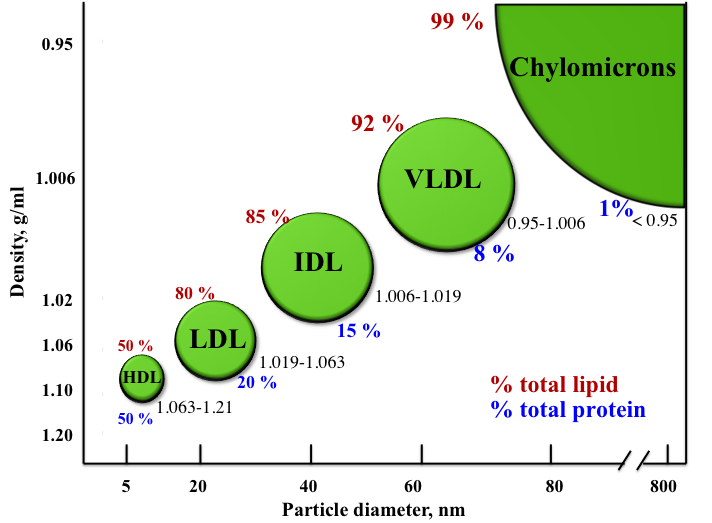24.2: Lipoproteins for Lipid Transport
- Page ID
- 86364
- Describe the difference in composition and function between the five classes of lipoproteins.
During times of feasting, lipids enter the body's metabolic pathways through the process of digestion. Any excess energy will be stored in adipose tissues. If food has not been eaten for a while, fasting, lipids mobilized from stored adipose tissue and synthesized in the liver can be used for energy. Transportation of nonpolar lipids through the bloodstream requires binding to water-soluble proteins like serum albumin or packaging in lipoproteins. There are five categories of lipoprotein defined by their composition and density, or the ratio of lipid to protein. Chylomicrons, which have the highest lipid to protein ratio, have the lowest-density, are responsible for transporting lipids from digestion into the blood and eventually to the liver. Following is a list of the remaining four lipoproteins and their functions:
- Very low-density lipoproteins (VLDLs) (0.96-1.006 g/cm3) are made in the liver from remnants of chylomicrons and transport triglycerides from the liver to various tissues in the body for energy or storage. As the VLDLs travel through the circulatory system, the lipoprotein lipase strips the VLDL of triglycerides. As triglyceride removal persists, the VLDLs become intermediate-density lipoproteins.
- Intermediate-density lipoproteins (IDLs) (1.007-1.019 g/cm3) transport a variety of fats and cholesterol left from VLDLs from the tissues to the liver where they are transformed into low-density lipoprotein.
- Low-density lipoproteins (LDLs) (1.020-1.062 g/cm3) carry cholesterol and other lipids from the liver to tissue throughout the body. LDLs are comprised of very small amounts of triglycerides, and house over 50 percent cholesterol and cholesterol esters. Once inside the cell, the LDL is taken apart and its cholesterol is released and used for membrane formation, steroid synthesis, or if in excess forming arterial plaques.
- High-density lipoproteins (HDLs) (1.063-1.210 g/cm3) are responsible for carrying cholesterol out of the bloodstream and into the liver, where it is either reused or removed from the body with bile.

You are probably familiar with HDL and LDL being referred to as "good cholesterol" and "bad cholesterol," respectively. This is an oversimplification to help the public interpret their blood lipid values, because cholesterol is cholesterol; it's not good or bad. LDL and HDL are lipoproteins, and as a result you can't consume good or bad cholesterol, you consume cholesterol. A more appropriate descriptor for these lipoproteins would be HDL "good cholesterol transporter" and LDL "bad cholesterol transporter."
For healthy total blood cholesterol, the desired range you would want to maintain is under 200 mg/dL. More specifically, when looking at individual lipid profiles, a low amount of LDL and a high amount of HDL prevents excess buildup of cholesterol in the arteries and wards off potential health hazards. An LDL level of less than 100 milligrams per deciliter is ideal while an LDL level above 160 mg/dL would be considered high. In contrast, a low value of HDL is a telltale sign that a person is living with major risks for disease. Values of less than 40 mg/dL for men and 50 mg/dL for women mark a risk factor for developing heart disease. In short, elevated LDL blood lipid profiles indicate an increased risk of heart attack, while elevated HDL blood lipid profiles indicate a reduced risk.The University of Maryland Medical Center reports that omega-3 fatty acids promote lower total cholesterol and lower triglycerides in people with high cholesterol.[1]
It is suggested that people consume omega-3 fatty acids such as alpha-linolenic acid in their diets regularly. Polyunsaturated fatty acids are especially beneficial to consume because they both lower LDL and elevate HDL, thus contributing to healthy blood cholesterol levels. The study also reveals that saturated and trans fatty acids serve as catalysts for the increase of LDL cholesterol. Additionally, trans fatty acids decrease HDL levels, which can impact negatively on total blood cholesterol.
- Omega-3 fatty acids. University of Maryland Medical Center. http://www.umm.edu/altmed/articles/omega-3-000316.htm. Updated August 5, 2015. Accessed September 28, 2017. ↵

